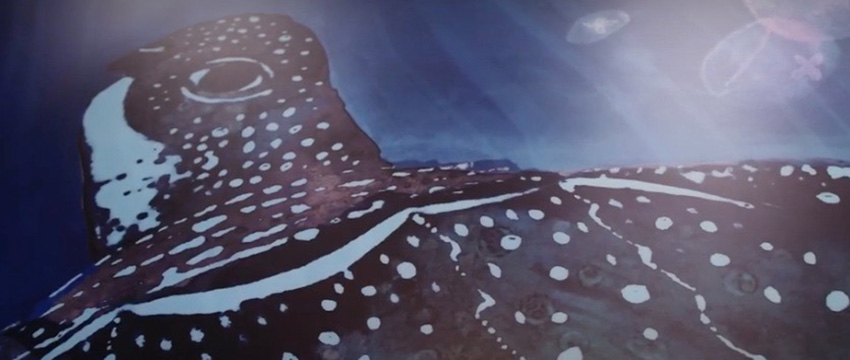Imagery speaks louder than words. It has the demonstrable power to elevate experience, spur creativity, promote productivity, and boost brand. In the built environment, architects and design professionals aren’t just designing a space, they are also inherently creating a connection and experience for those who encounter that space. With advances in graphic and product technology, designers can incorporate high-end, digital artwork and imagery optimized for spaces such as offices, hospitals, and retail, bringing vitality to areas that would otherwise be merely functional. Through critical design research into art and biophilia, imagery can be harnessed to “work” for the occupants in any commercial building. Art, printed on an architectural product, can bring a brand, an idea, or even a feeling to life.

Photo courtesy of Inpro
Bright colors, integrated artwork, and direct connections to the exterior are in high demand for the built environment.
THE POWER OF ART AND IMAGERY IN THE BUILT ENVIRONMENT
Art is no longer confined to something in a frame that hangs on the wall. Art today can be ultimately functional, helping spaces work better for everyone. Like a real natural landscape, the whole of a building or design project is greater than the sum of its parts. Most of the public spaces through which people move, from offices and schools to hospitals and transport hubs, owe something to the “modern” movement and its penchant for no-frills, pared-down design. While modernism has been the ruling standard, unchallenged for a generation, there is a sudden and renewed interest in rich textures, patterns, and curves, the very features of classical architecture that modernists once avoided.
Those professionals thinking seriously about design and its human impacts have learned that natural forms, from the vein patterns in leaves to the curves of the human body, are based on fractals─a similar patterns recur at progressively smaller scales─rather than grids. Human beings are drawn to fractals on a visual level and, on a deeper level, find these natural patterns emotionally restorative. Right angles, in contrast, are harsh and can even be exhausting for occupants. Through critical design research into art and biophilia, and from the inspiration that guides it, product manufacturers are increasingly looking add art for the occupants in any commercial building. This includes integrating art throughout a space and across various architectural products.
For architects seeking to populate their designs with natural forms and to capture both the visual and visceral response to fractals, manufacturers are providing new, high-tech solutions through common architectural products. Designers can now incorporate high-end, digital artwork optimized for spaces such as offices, schools, hospitals, and more. Materials such as protective wall coatings can be transformed to host art and designs that bring vitality to spaces.
“The possibilities are exponential when using imagery on printed wall protection relating to experiential design and biophilia. Your wall can not only take an impact, but also make an impact,” says Ryan Roessler, Product Manager of Door and Wall Protection at Inpro.
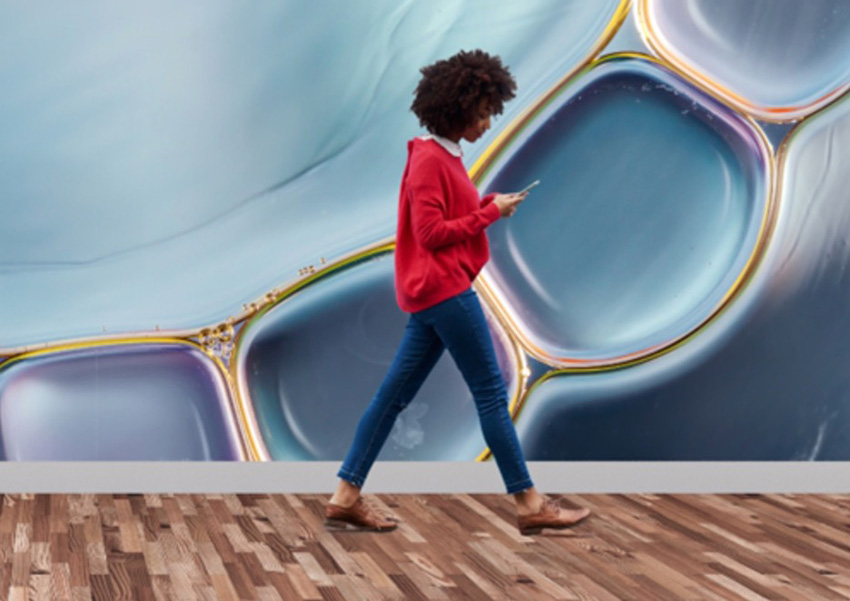
Photo courtesy of Inpro
The natural world evokes a powerful response from people. Harnessing biophilic elements elevates the built environment.
The Possibilities of Art in Design
Using art within a building creates inspiration, fosters education, promotes wayfinding, and can bolster branding. Beauty in architecture nourishes the human emotional brain argues Semir Zeki, Professor of Neuroaesthetics at University College London. Zeki goes further, suggesting beauty should be a quality in all buildings and that humanity has the ability to recognize this beauty across all cultural divides. Zeki’s research posits that the appreciation of beauty is hardwired into the human brain. People seek the beautiful to nourish the emotional brain since, from a neurobiological point of view, all areas of the brain must be continually nourished in a way that corresponds to their specific functions. “One reaches the inevitable conclusion that beauty must be a guiding characteristic in all designs that aim to enhance human experience,” writes Zeki.1 He concludes that, whatever other demands go into architectural design, beauty must be a central element. Its experience adds to the health of its individuals and hence to society’s well-being. “It is not a luxury but an essential ingredient in nourishing the emotional brain.”2
The artistic possibilities for a design are limited only by the designer's imagination. New technologies and materials have grasped and transformed the once-limited palette of products available to signage and protective wall cladding, offering an incredible range of design choices. No longer limited to boring beige or grim grays, these materials can display any work of art desired and integrate easily into design goals.
Art can generate inspiration for occupants. Engaging with art is essential to the human experience, write Brian Kisida and Daniel H. Bowen. “Almost as soon as motor skills are developed, children communicate through artistic expression. The arts challenge us with different points of view, compel us to empathize with ‘others,’ and give us the opportunity to reflect on the human condition. Empirical evidence supports these claims: Among adults, arts participation is related to behaviors that contribute to the health of civil society, such as increased civic engagement, greater social tolerance, and reductions in other-regarding behavior.”3 The new diversity of colors, material, and textures of impact-resistance products offer designers and facility staff limitless options to enhance the aesthetics of a facility’s interior.
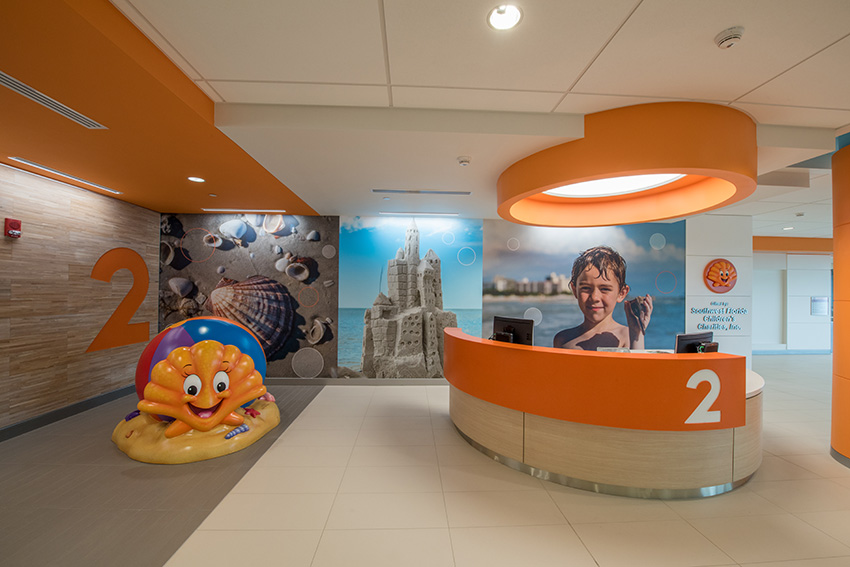
Photo courtesy of Inpro
Using distinctive combinations of artwork and color enables wayfinding for occupants navigating buildings and campuses.
The human adaptation to nature’s fractals also influences many stages of the human visual system, from how the eye moves when acquiring the visual data of fractal patterns to how the brain responds when processing their characteristics, notes Professor Richard Taylor from the University of Oregon/ Fractals Research (USA) and ScienceDesignLab (SDL). Research at the SDL has led to the “fractal fluency” model, which asserts that human vision has become fluent in the visual language of nature’s fractals and can process their features efficiently, “creating an aesthetic experience accompanied by a decrease in the observer’s physiological stress levels.”4 By incorporating fractal patterns into the built environment, the well-being of occupants should be enhanced.
Art can educate and address social aspects of the built environment. Imagery is a highly effective strategy for increasing comprehension, reports The University of Kansas Department of Special Education. Imagery strategies involve activating the memory by taking what is to be learned and creating meaningful visual, auditory, or kinesthetic images of the information.5 Findings from Houston’s Arts Access Initiative provide strong evidence that arts educational experiences can produce significant positive impacts on academic and social development in children. School students exposed to art experienced a 3.6-percentage point reduction in disciplinary infractions, an improvement of 13 percent of a standard deviation in standardized writing scores, and an increase of 8 percent of a standard deviation in their compassion for others.6
Art is an effective method to create wayfinding. As defined by the Wayfinding Society for Experiential Graphic Design, wayfinding refers to information systems that guide people through a physical environment and enhance their understanding and experience of that space. “Wayfinding is particularly important in complex built environments, such as urban centers, healthcare settings, educational campuses, and transportation facilities. As architectural environments become more complicated, people need visual cues such as maps, directions, and symbols to help guide them to their destinations. In these often high-stress environments, effective wayfinding systems contribute to a sense of well-being, safety, and security.”7
Adding imagery throughout a design brings continuity throughout the building and guides how people interact with the space. For example, a building that selects nature as a theme can create variations on each floor within that theme to help people remember different locations and to change up the scenery.
Art can support and build the message of branding for a school, group, or business.Brand imagery is one tool within the kit of brand identity that defines the aesthetic appearance of a brand’s core messaging. Brand imagery comprises the visual, story-telling component of a brand identity.8 Mismatched visuals, or a space that is generic, can work to the detriment of a business’s brand. On the other hand, matching the design scheme of a brand within a building or space to invoke positive feelings for workers, occupants, clients, or patients heightens the experience, not only within the space but also, by association, for the brand. United visuals can further the messaging of the space. This type of cohesiveness in imagery will strengthen the brand or business and elevate the experience of clients or other visitors to the professional space.
The Possibilities of Printed Architectural Products
Through the careful selection of products and materials to carry forward their artistic vision, architects, designers, and facility managers can create an artistically integrated space. New digital imaging and printing techniques have enabled endless possibilities when it comes to adding art to architectural products, including wall coverings, panels, shades, and signage. Design professionals are no longer limited to solid colors or patterned wallpaper. Product design experts can work with clients to select imagery suited to their brand. Stock photography and curated artworks from artists can be showcased through architectural products.
Any image can find a place on a project’s walls, signage, or even window treatments. Art is no longer something relegated to hang on the wall as an ornament, it can be transformed into something that is ultimately functional. Complete customization enables architects and designers to create unique, one-of-a-kind products that produce an unforgettable experience for building occupants. The colors, material, textures, and impact-resistance levels of these products also offer designers and facility staff limitless options to enhance the aesthetics of a facility’s interior, while delivering much-needed protection to the edifice itself.
Walls are one of the largest elements of the interior. Adding design integrated throughout wall protection gives walls an additional purpose while expanding their longevity and enhancing protection against damage. Durable wall panels can be used in high-traffic spaces prone to damage and deterioration. Specifying printed wall protection provides a protective wallcovering that can be applied directly to the wall at virtually any size. When the graphic is back-printed onto clear sheet, like PETG, the custom artwork, photography, or image remains vivid and will not get scratched over time.
In areas that do not need enhanced protection, printed wall art offers completely customizable design options, enabling the professional to choose impactful photography, logos, or colors to align with the brand and continue the design scheme. Printed signage allows art to be integrated in creative ways throughout the space. Printed cubicle curtains, window treatments and shower curtains, made from fiberglass, polyester, vinyl, and acrylic, can help to block glare and unwanted heat while still allowing a degree of natural light. When combined with digital print capabilities, these fabrics create a perfect way to add and display art within commercial buildings.
CREATING NATURAL CONNECTIONS
Incorporating biophilia into a project’s design allows people to maintain their biological connection to nature, even indoors. Humans have an innate affinity for the life-supporting aspects of the natural world. This attraction to nature is referred to as biophilia, a term literally meaning "love of nature." Understanding this inherent attraction to the natural world has spurred innovation in the architectural community. Designers are starting to capture opportunities to reconnect occupants with nature by incorporating biophilic elements in their designs. Working through digital imagery or prints on an architectural product, art that features biophilia can play an impactful role.
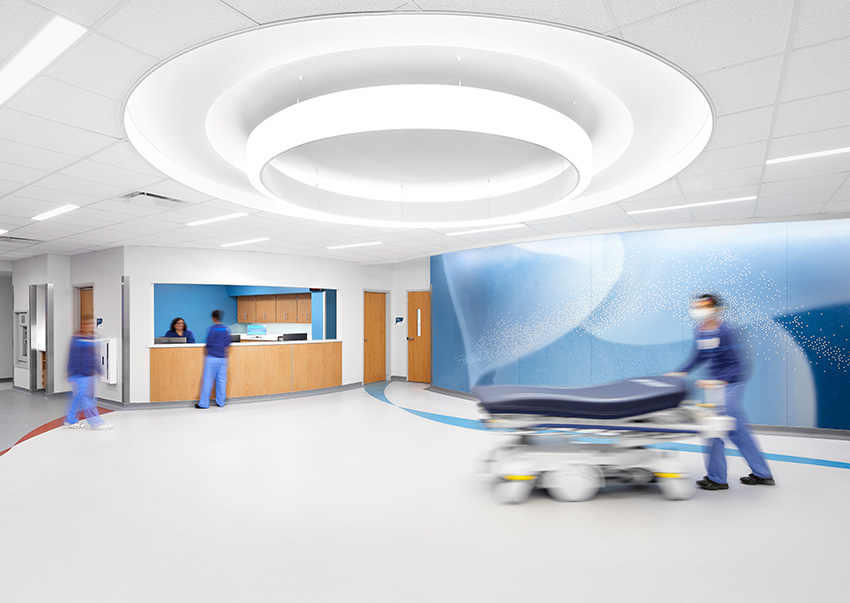
Photo courtesy of Inpro
Adding artwork to walls, one of the largest elements of the interior, allows for expansive design opportunities.
What is Biophilia?
Biophilia conveys the natural connection to the greater ecological system that people crave. Biophilia refers to the human desire to connect with nature and other living things. Biophilic design can come via many forms. A project utilizing biophilic design may incorporate nature-related imagery, increase the use of natural lighting, maximize natural ventilation, and integrate natural textures in finishes and furnishings.
Defined by psychologist Eric Fromm in 1964, the concept of the biophilic experience was examined and popularized in 1984 by the sociobiologist EO Wilson in his book Biophilia.9 Wilson defined biophilia as “the innate tendency to focus on life and lifelike processes”. He utilized the term “biophilia” to describe his own deep feelings of connection to nature during a period of exploration and immersion in the natural world. Wilson postulated that this biophilic propensity developed as part of evolutionary survival and that survival mechanism still encompasses certain characteristics that remain with humans, even in modern cities.10
A core theme from biophilic design literature is that humanity has lost something in its approach to building design in modern times.11 Human affiliation with nature is seen to be historically reflected in organic building designs and materials, in patterning and spaces that mimic those of nature, and in traditional living with close, but respectful proximity, to the natural environment. This movement stands opposed to the sterility and harshness it sees in modernism.
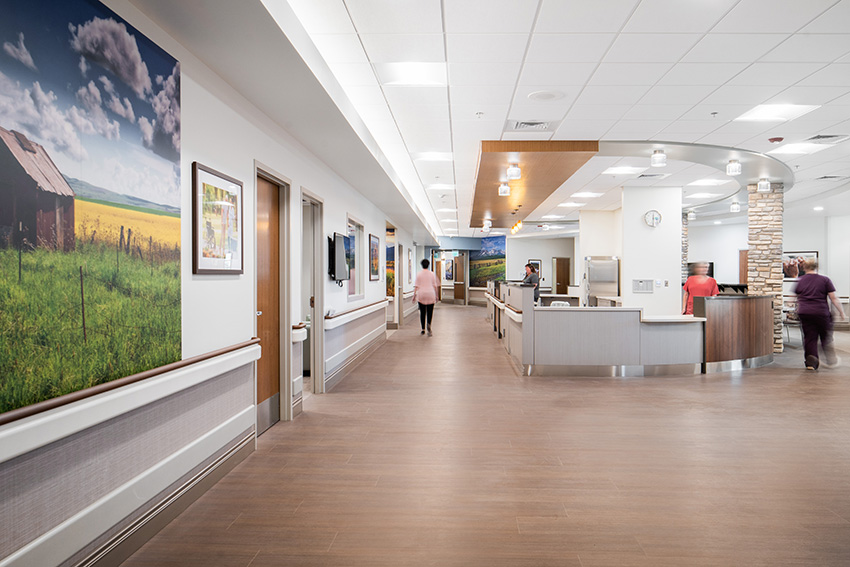
Photo courtesy of Inpro
Bringing biophilic design elements into healthcare settings decreases stress for patients and staff while enhancing healing and recovery.
Professor Semir Zeki found that, as buildings are created and planned, the designer innately has already looked at nature. “It would be surprising if something of that biological experience did not seep into these artifactual designs,” writes Zeki. “Indeed, the Roman architect Vitruvius emphasized that beauty in architecture has its source in the contemplation of the natural world, including the human body.” Architects, in order to capture beauty, often instill into an architectural design certain properties derived from more biological percepts such as those of faces or bodies or landscapes.12 Architects can cater to biophilia through incorporating art in their projects. Art, as displayed through architectural products, allows holistic integration of natural elements.
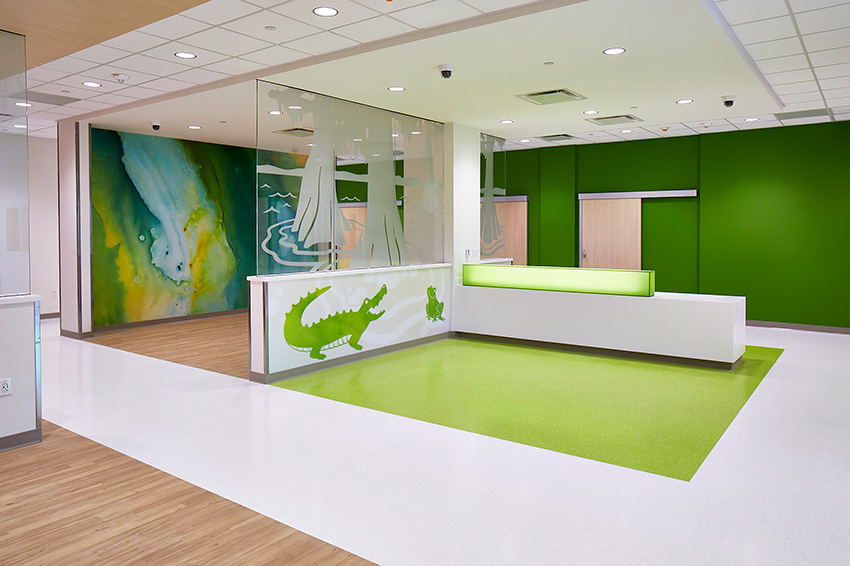
Photo courtesy of Inpro
Using distinctive combinations of artwork and color enables wayfinding for occupants navigating buildings and campuses.
What are the Benefits of Biophilic Design?
Evidence increasingly shows that biophilic design boosts mental health, healing, and creativity.
The global health challenges of the twenty-first century have highlighted and offered a unique window on the fact that a new way of thinking and a change in how people consider buildings is called for. Americans, on average, spend approximately 90 percent of their time indoors.13 That means that they have a minimal 10 percent, or less, of time engaged with natural spaces. Evidence-Based Design indicates the importance of using interior spaces to foster the missing link to nature. Data from studies on healthcare spaces demonstrates that biophilia helps occupant mood, assists in healthcare settings for both patient and staff, and can decrease time spent in recovery for patients.
Healthcare, by necessity, takes place in a controlled, interior space. Patients in healthcare settings often experience high stress, either due to their actual condition or the difficulties of diagnostic procedures and testing.
In 1984, a landmark paper by Dr. Roger Ulrich helped establish the field of Evidence-Based Design. Ulrich’s study found that patients who had hospital rooms with a window required less pain medication and recovered at faster rates than patients in rooms without windows. The organization of healthcare services through an approach that considers human needs in their entirety, and not in a strictly therapeutic sense, is yielding considerable fruit for architectural expression. According to several studies, the humanization of healthcare spaces and contact with nature can empower the patient and have a positive impact by reducing stress and pain and improving emotional well-being.14 Biophilia in medical facilities improves occupant mood, helps in healthcare, and can decrease time spent in recovery for patients. Studies have shown that looking at images of nature is healing, generating an impact similar to actually spending time in nature. Art, then, can become a crucial component of any healthcare space by bringing in the natural world.
“Healthcare facilities that employ the principles of biophilic design improve patient outcomes and reduce staff stress,” writes Gary McNay.15 Simple design choices, like using more natural building materials or installing a circadian lighting system, have allowed healthcare designers to transform hospitals into more comforting environments.
Biophilic elements can also enable wayfinding. Healthcare campuses present a unique set of navigational challenges. Often, these environments have developed over time and encompass multiple buildings. This makes navigation among the buildings complex. In addition, patients and families who visit healthcare campuses are often under stress. Wayfinding systems can help reduce their stress by providing easy-to-follow signage and legible directions to their destinations, according to the Society for Experiential Graphic Design. Using biophilia, and coordinating themes, imagery, and colors, minimizes reliance on text-based messaging and instead places the burden on more easily interpreted non-text cues such as colors and symbols.16
Art in the Healthcare Setting
Art itself can be a powerful healing force. The American Congress of Rehabilitation Medicine (ACRM) lists multiple benefits from art therapy: art reduces stress, improves focus, helps one to better process emotion, enables a person to imagine a more hopeful future, and improves communication skills. Christianne Strang, a professor of neurosciences at the University of Alabama Birmingham and former president of the American Art Therapy Association says: “Creativity in and of itself is important for remaining healthy, remaining connected to yourself and connected to the world.”17
Through studies using magnetic resonance imaging (MRI) and brain-wave scanning, researchers were able to see that:
- Pleasure centers in the brain are triggered by viewing art and images.
- Additionally, several other areas of the brain can be stimulated.
There is increasing evidence in rehabilitation medicine and the field of neuroscience that art enhances brain function by impacting brain wave patterns, emotions, and the nervous system. Art can also raise serotonin levels. These benefits don’t just come from making art, they also occur by experiencing art. Observing art can stimulate the creation of new neural pathways and ways of thinking. Any type of creative expression allows a person to imagine new ways to communicate and engage with the world. It also engages the brain’s neuroplasticity, helping patients recover from things like traumatic brain injuries or stroke, ACRM research states.18
In a study conducted by Zeki, Chair of Neuroaesthetics at University College London, participants underwent brain scans while being shown images of paintings by major artists.19 The study found that when people viewed the art they thought was most beautiful, blood flow increased by as much as 10% to the region of the brain associated with pleasure, the equivalent of looking at a loved one.
Art accesses many of the advanced processes of the human brain, such as intuitive analysis, expressivity, and embodied cognition. Artists are often better observers and have better memory, and this may be due to how art affects the brain’s plasticity.20
Though further studies are certainly required in order to deepen the understanding of the human-nature relationship and its impact on health, as biophilic evidence-based design increases, it is changing the approach regarding patients’ health by considering a new vision of medicine, healthcare and healing environment. It is also providing proof that reinforces the design professional’s urge to incorporate more beauty and natural elements into the built environment.
PRO TIPS: SELECTING IMAGES FOR A PROJECT
Artworks present a cohesive design when they are placed in harmonious relation to one another and selected together to define and present a fully integrated space.
Adding imagery throughout the built environment brings continuity to both the building and the occupant experience. With the right materials, design professionals can craft a striking design and ensure sustainability and significant savings by stopping damage before it happens. Thanks to innovations in technology, facility designers no longer have to compromise their visions with drab institutional products, nor do they have to sacrifice durability for aesthetics.
>Walls are one of the largest elements of the interiors. Printed wall protection provides them with a purpose. However, artworks function better when they are placed in harmonious relation to one another. An integrated space requires cohesiveness within the artistic selections.
How to choose imagery:
Step 1: Connection. Consider the type of connection desired between occupant and the built environment.
Step 2: Consider your brand. Imagery in a space should be cohesive and bring continuity to the space and support the desired connection.
Step 3: Create a theme. Determine the best arrangement for images, including desired impact and placement.
Step 4: Sizing and application. Based on design criteria, identify image location and product type throughout the environment.
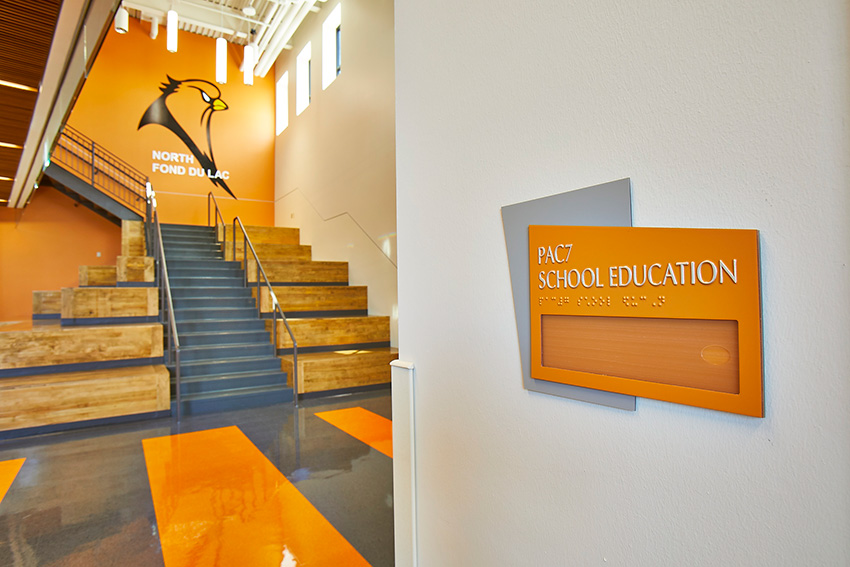
Photo courtesy of Inpro
The concept of imagery in branding is valuable in diverse environments, including schools. Carefully chosen images and art can highlight an educational group’s values, mission, and community.
Practical Application: Selecting Imagery for a School
The burgundy, maroon color of Harvard and the deep navy of Yale are immediately identifiable. The color schemes link indelibly with the school logos and large brick, colonial architecture. Art, design, and branding reach beyond just a logo or the crest on a student’s uniform. They can unite to form an institution’s voice, image, reputation, and what differentiates the school from competitors. A school’s brand is about defining what the institution is to staff, students, and the community. The goal of a design is to reinforce the school’s immediate and future goals, values, and mission.
Schools that effectively utilize branding have capitalized on multiple creative channels to share who they are. But schools can also promote their brand through effective use of design and architectural products.
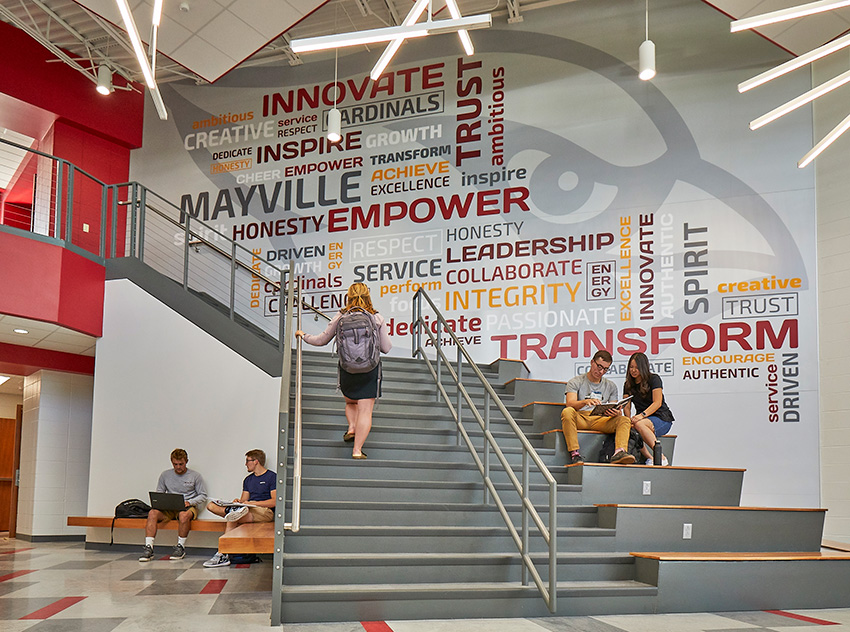
Photo courtesy of Inpro
Wall graphics can provide an enhanced learning environment while distinguishing the institution’s core values.
Architectural Product Elements: Wall Graphics
Wall graphics can play a significant role in enhancing a school’s branding by creating a visually engaging and stimulating environment that reflects the school’s values, mission, and culture. Education systems can utilize wall graphics to:
- Showcase the school’s identity. Display the school’s name, logo, and colors prominently throughout the campus, reinforcing the institution’s identity and creating a sense of pride among the students, faculty, and staff.
- Communicate the school’s values and mission. Through inspirational quotes, images, and graphics, schools can help create a positive and welcoming environment that reflects its educational philosophy and goals.
- Create a sense of community. Wall graphics can be used to highlight the school’s community spirit and celebrate its achievements. This can include displaying pictures of students and staff members, showcasing student artwork and accomplishments, and highlighting the school’s athletic teams and extracurricular activities.
- Enhance the learning environment. Create visually stimulating and engaging spaces that promote creativity, curiosity, and critical thinking. For example, graphics can be used to display educational content, diagrams, and maps that support the curriculum, or large-scale imagery for positive emotional effects.
Architectural Product Elements: Signs
School signage does not start and end at the school gates. School signage can play a crucial role in contributing to a school’s branding efforts by creating a consistent and recognizable visual identity throughout the campus.
- Signs can showcase the school’s identity. Displaying the school’s name, logo, and colors prominently throughout the campus, reinforces identity and creates a sense of pride among the students, faculty, and staff.
- Signs create a first impression. School signage can be the first point of contact for visitors, students, and parents when they enter the campus. It can create a positive and welcoming first impression by displaying the school’s name, logo, mascot, and colors prominently.
- Signs can reinforce brand identity. School signage can help reinforce the school’s brand identity by displaying consistent branding elements throughout the campus. This can include using the same fonts, colors, and graphics in all signage and communication materials.
- Signs enhance wayfinding. School signage can be used to enhance wayfinding by displaying directional signs, maps, and information about the campus layout. This can help visitors and students navigate the campus easily and feel more safe and comfortable.
- Signs communicate key messages. School signage can be designed to communicate key messages, such as the school’s mission, values, and achievements. This can help build a sense of community and pride among students, staff, and parents.
Architectural Product Elements: Framed Wall Art
Wall art can play a vital role in enhancing the learning experience for students. It can inspire, inform, and engage them in ways that traditional teaching methods cannot. Wall art can also play an important role in a school’s branding by creating a visual representation of its values, mission, and culture.
- Wall art can create consistency of vision. Wall art can be used to reinforce a school’s branding by featuring its logo, colors, and other visual elements consistently throughout the school. This can help create a cohesive and recognizable brand identity that students, parents, and the wider community can easily identify.
- Wall art can inform through storytelling. Wall art can be used to tell the story of a school’s history, traditions, and achievements. This can help build a sense of pride and connection among students, staff, and alumni.
- Wall art can differentiate. Wall art can be used to differentiate a school from its competitors by highlighting its unique qualities and strengths. This can be especially important in a competitive education market where schools are vying for students and funding.
- Wall art can foster community engagement. Wall art can be used to engage the wider community by featuring local artists, historical landmarks, and cultural icons. This can help build stronger relationships with local businesses, organizations, and residents.
- Wall art can inspire students and staff by featuring motivational quotes, images, and messages. This can help reinforce a school’s values and mission and create a positive and uplifting atmosphere.
- Wall art can aid memory retention. Visual aids such as wall art can help students retain information more easily. They can serve as a reminder of important concepts and facts, which can be especially helpful for students who are visual learners.
- Wall art can create a positive and inviting environment that can enhance students’ moods and attitudes towards learning. This can be especially beneficial for students who struggle with motivation or have a negative perception of school.
Wall art can promote cultural appreciation. Wall art can expose students to different cultures and perspectives, which can broaden their understanding and appreciation of the world around them. Art can be a powerful tool for creating and promoting a school’s branding. By using it strategically, schools can build a strong and recognizable brand identity that reflects their values, culture, and achievements while also germinating feelings of belonging for students.
BEST PRACTICES WHEN SPECIFYING INTERIOR WALL PROTECTION APPLICATIONS
Selecting wall protection products increases durability and sustainability of the overall design.
It’s a difficult balancing act to design beautiful interiors that can also stand the test of time in harsh environments, such as healthcare or retail. Architects and design professionals can slow the inevitable wear and tear by thinking long-term and specifying products that not only preserve their design and artistic vision but also serve building owners in preserving a structure long after the ribbon is cut. This can mean, in high-use areas, selecting products that protect the planned interior from accruing damage in the first place.
The investment in high-quality wall protection products makes it much easier to maintain a clean, well-kept facility appearance that makes a positive impression on both clients and employees. Wall protection panels may be a new expense, but they can eliminate hidden maintenance costs while offering the additional opportunity of hosting art to improve the overall experience of occupants.
A Look at Wall Composition
The materials that lie beneath a wall will dictate what kind of protection is needed. Understanding wall composition helps better inform decisions about the type of architectural products that will protect the overall design. The four common interior sub-wall products are:
- Drywall – baseline wall construction material.
- Cement Board – offers increased resistance to higher levels of abuse. May be used in high moisture applications and is often used in selected areas requiring moisture resistance
- Fire-rated Plywood – offers increased resistance to higher levels of abuse and more secure fastening of mechanical systems to wall, such as handrails and wall guards. Used in targeted areas to increase protection from known or anticipated heavy abuse.
- CMU (Concrete Masonry Unit) wall systems – provides 2-hour fire-rated walls in school gymnasiums and mechanical rooms. May be clad with wall protection to reduce painting or to soften the look aesthetically.
Preventing Damage to Extend Design Life with Architectural Products
Door and wall protection products serve as preventative “medicine” to keep facilities looking good, long after the grand opening. A list of architectural products that provide door and wall protection can be found in CSI MasterFormat Division 10 26 00 – Wall and Door Protection:
- Corner Guards
- Bumper Guards/Wall Guards
- Bumper Rails
- Protective Corridor Handrails
- Protective Wall Covering – rigid polymer sheet, solid surface wall cladding, flexible protective wall covering
- Door and Frame Protection – kickplates, door frame guards
Specifying Rigid Sheet Wall Protection
Placement, material type, and finishes are critical elements of wall protection selection.
Protective wall coverings are engineered with rigid sheet wall protection to endure the toughest commercial damage. When beginning a new construction or renovation project, it is wise to engage in predictive planning. Predictive planning specifically identifies the potential causes and levels of abuse, and then matches the targeted wall protection based on its size, impact absorption, weight bearing, and desired aesthetic.
- Selecting the right material. What level of impact resistance is needed? What type of material makes up the wall? Does the material need to be non-porous, or have the ability to endure frequent, stringent cleaning protocols without fading, warping, or staining
- Sheets versus rolls. Sheets allow for higher levels of impact resistance. Rolls can accommodate half-wall or wainscot applications and provide a significant reduction in seams, which gives a smoother, less-interrupted finish.
- Finishing touches. When deciding between a trim versus caulk finish, trim provides a more highly finished look to the installation but is more expensive to furnish and install. Caulks finish the seam only.
- Adding imagery, woodgrain, colors, or pattern to the protective elements.
- Ensuring proper installation. Smooth and proper adhesive installation is critical. As with all wall coverings, proper surface preparation and adhesive is critical to prevent mold behind wall cladding.
Starting with the Right Materials
With the right materials, occupants and staff can enjoy both a striking design and signifcant savings by stopping damage before it starts. The colors, material, textures, and impact-resistance levels of these products offer designers and facility staff limitless options to enhance the aesthetics of a facility’s interior, while delivering much-needed protection. Thanks to innovations in technology, designers no longer have to compromise their visions by using drab institutional products, nor do they have to sacrifice durability for aesthetics.
END NOTES
Amanda C Voss, MPP, is an author, editor, and policy analyst. Writing for multiple publications, she has also served as the managing editor for Energy Design Update.

